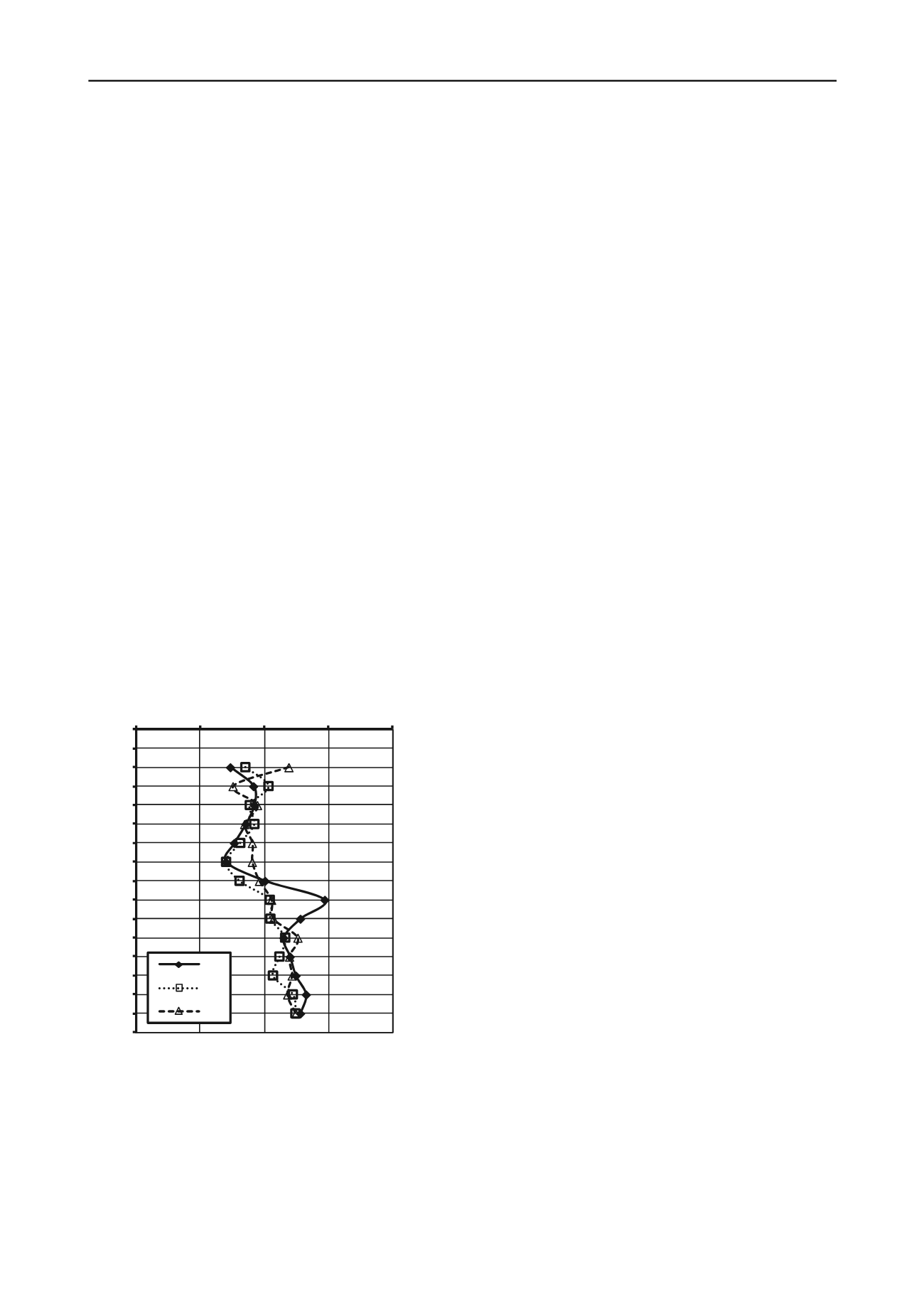
598
Proceedings of the 18
th
International Conference on Soil Mechanics and Geotechnical Engineering, Paris 2013
Proceedings of the 18
th
International Conference on Soil Mechanics and Geotechnical Engineering, Paris 2013
st resu
ussed
ls. Th
tion h
e we
bmerg
bmerg
v
for
situ
t
ll. O
guide
in situ
evaluated parameters to laborato
const
ts) we
mic te
ed abo
s wa
ls. Sin
rigid
arded
echani
unced
standard
diagrams. Although velocities generally increase w
depth, there are weaker and stronger intervals at certain
depths in M2 and M1 boreholes. The M3 location sho
constant increase in shear wave velocity by depth.
The influence of presence of water on DMT te
interpretation in terms of modulus M
v
was disc
Mulabdic and Bruncic (2000) for natural soi
concluded that error in water depth assump
limited influence on interpreted M
v
values. Her
dealing with compacted clay, never being su
and obviously soil would be softer if it were su
That is, it is difficult to predict soil modulus M
state of a submerged embankment fill from an
in
performed on a non-submerged embankment fi
comparison as shown in Fig. 6 can be used as a
correcting
lts
in
ey
ad
are
ed,
ed.
the
est
nly
for
ry
ant
re
sts
ve
ve
ce
ity,
as
cal
in
values, but even then correction would not be
with depth.
Tests marked as M1, M2 and M3 (DMT-tes
performed in one run as standard tests and seis
(SDMT), using a special seismic probe install
blade (Cavallaro et al, 2006). Fig. 8 show
velocities measured in 0,5-meter depth interva
velocity is a „measure“ of soil structure and its
variability of those two parameters should be reg
a basic indication of the variability of soil m
properties. These variabilities are more prono
wave velocity diagrams than in CPT and DMT
ith
ws
0,0
0,5
1,0
1,5
2,0
2,5
3,0
3,5
4,0
4,5
5,0
5,5
6,0
0
100
200
300
400
6,5
7,0
7,5
8,0
M1
M2
M3
d (m)
v (m/s)
nt SDMT
locations, depth intervals 0,5 m
3. CONCLUSIONS
The paper presented the case of an earth dam of a poor
construction quality. In order to characterize clay fill in
the embankment in terms of its physical and mechanical
properties, CPT and DMT tests were performed in
addition to borings and laboratory testing. The purpose of
e compacted clay
ties in a
erent positions on
ir results
standards. Based
itu
and laboratory
e drawn from this
omogeneous clay
th, both in static
T), (2) common
results should be
priate corrections
d clays, since they
we deal with the
of importance for
erties whether the
at the time of
MT tests showed
be valuable aid in
oth in terms of
anical properties;
cularly useful; (5)
in situ
test
order to properly
account for effects of the presence of water (submerged
ed), specific structure of compacted soil,
specific stress distribution and limited experience in
compacted
KNOWLEDGEMENTS
y Elektroprojekt,
analysis
.
dam, Elektroprojekt,
Zagreb, 2006.
ial design - Part 2-
ocone tests in clay.
rt No. 42, Linköping,
J.M. 1997. Cone
Practice, E & FN
Spon, pp 312.
ilatometer", ASCE
pp 299-321.
Mulabdić, M. and Brunčić, A. (2000.). Prilog analizi primjene
dilatometra Marchetti, Građevinar, Vol 52, No. 1, pp 9-17
(in Croatian).
Robertson,P.K. 1990. Soil classification using the cone
penetration test. Canadian Geotechnical Journal, 27 (1),
151-8.
Cavallaro, A., Grasso, S. and Maugeri, M. 2006. Clay Soil
Characterization by the New Seismic Dilatometer
Marchetti Test (SDMT), Proc. 2
nd
international flat
dilatometer conference.
Figure 8. Measured shear wave velocity at differe
these two
in situ
tests was to determin
condition and its physical and mechanical proper
continuous profile by depth and at diff
dam crest. The tests and the interpretation of the
were performed according to accepted
on analyses of all test results – from
in s
tests – the following conclusions can b
case: (1) CPT and DMT detected inh
conditions very clearly along the dep
testing and in seismic testing (SDM
interpretation of CPT and DMT test
used with caution, allowing for appro
when tests are performed in compacte
are developed for natural clays, and here
compacted – man made soil; (3) it is
the analysis and perception of clay prop
embankment is dry or submerged
performing
in situ
tests; (4) CPT and D
remarkable repeatability and proved to
characterizing embankment quality, b
inhomogeinity and physical and mech
SDMT results also proved to be parti
local correlations between laboratory and
results should always be used, in
or non-submerg
using
in situ
tests for the characterization of
soils.
4. AC
Cooperation with designing compan
Zagreb, Croatia, in the planning, execution and
of investigation work is highly appreciated
5. REFERENCES
Design solution documentation for Opatovac
EN 1997-2:2006. Eurocode 7: Geotechnc
Ground investigation and testing.
Larsson, R. and Mulabdić, M. 1991. Piez
Swedish Geotechnical Institute, Repo
pp 240.
Lunne, T., Robertson, P.K., Powell, J.
Penetration Testing in Geotechnical
Marchetti S. 1980. "
In Situ
Tests by Flat D
Journal GE, Vol. 106, No. 3, March 1980,


